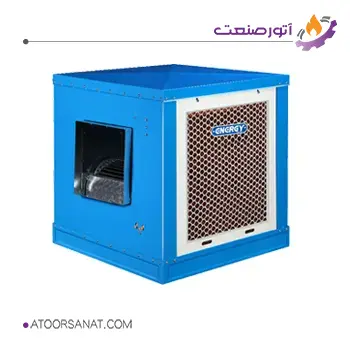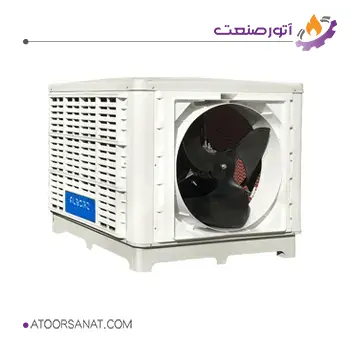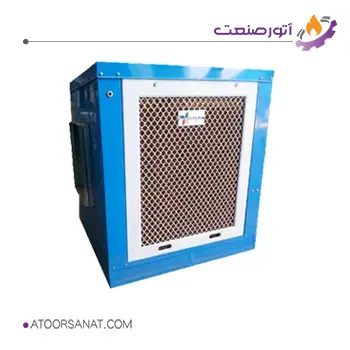Evaporative Cooler

Evaporative Cooler
An evaporative cooler is an industrial equipment designed for air conditioning that cools air through the evaporation of water. It is used in hot and dry regions to cool the air during the warm seasons. Evaporative coolers operate on the principle of evaporative cooling and differ from other air conditioning systems that use vapor compression or absorption refrigeration cycles.
Evaporative cooling is a process in which water absorbs a large amount of heat to evaporate, or in other words, the temperature of dry air is reduced through the phase transition of water from liquid to vapor (evaporation). In these coolers, outside air passes over water-saturated pads, and the water in the pads evaporates, lowering the air temperature before being directed into the house.
In very dry climates, evaporative cooling of air has an additional advantage: it humidifies the air with more moisture for the comfort of occupants, contributing to a more pleasant atmosphere. Additionally, creating humidity prevents the air from drying out, causing wooden objects to crack and static electricity to build up in these areas.
Evaporative coolers are environmentally friendly and are a cost-effective means of air conditioning. They are used in homes, garages, open patios, covered porches, warehouses, and entertainment or dining spaces worldwide. The global market value of this cooling equipment reached $7.6 billion in 2019 and is projected to reach $19.8 billion by the end of 2026.

Features:
- Country of Origin: Iran
- Ventilation Capacity: from 4,420 to 7,990 cubic meters per hour
- Applications: For residential, commercial, industrial, and other uses.

Features:
- Country of Origin: Iran
- Ventilation Capacity: from 15,000 to 18,000 cubic meters per hour
- Applications: For residential, commercial, industrial, and other uses.

Features:
- Country of Origin: Iran
- Motor Type: Single-phase – Three-phase
- Applications: For residential, commercial, industrial, and other uses.
How Evaporative Coolers Work
Evaporative coolers, or evaporative coolers, reduce air temperature using the principle of evaporative cooling, unlike conventional air conditioning systems that use vapor compression or absorption refrigeration. A simple example of natural evaporative cooling is sweating, where the evaporation of sweat on the skin cools the body.
Evaporative cooling is a very old process dating back thousands of years to ancient civilizations in Iran and Egypt. The oldest example of an evaporative cooler in the world is the windcatcher, which was invented in Iran about thousands of years ago. The windcatcher draws the outside air into itself and cools the air with the water trays inside, directing it into the house. Modern evaporative coolers are based on early models built in the 1900s in the United States.
In the evaporative cooling process, the energy required to evaporate water is taken from the sensible heat of the air, affecting the air temperature and causing it to decrease and the humidity to increase. In this equipment, a blower uses electrical energy to draw air from the outside environment into the cooler body, and before the air enters the cooled space, it passes through wetted pads made of cellulose or similar materials so that evaporation occurs and the air temperature decreases.
The more water circulating in the evaporative cooler, the greater its cooling power. A small pump with spray water keeps the pads wet, and the evaporated water, along with the cooled air, enters the space. In vapor compression or absorption refrigeration systems, the vapor of the fluid is compressed and re-evaporated in a closed system with the consumption of energy to continuously bring the environment to a comfortable temperature.
Components of an Evaporative Cooler
The main components of an evaporative cooler include:
- Electric motor: The drive for the blower of the evaporative cooler is a two-speed electric motor with two windings, whose power is selected according to the cooling capacity of the cooler. The evaporative cooler motor is of the squirrel cage type and has a capacitor starter. The motor in these coolers typically rotates at 1000 rpm at low speed and 1500 rpm at high speed, consuming 1 and 6.5 amperes of current, respectively.
- Capacitor starter: The capacitor starter is connected in series with the motor winding and provides the phase difference required to start the motor and then disconnects from the circuit.
- Pulley and belt: The transmission of torque between the motor and the blower is done by two pulleys and a belt.
- Centrifugal fan: The centrifugal fan is responsible for sucking and blowing air and is located on a shaft between two bearings. The centrifugal fan consists of several blades arranged in a specific shape and angle around a cylinder.
- Float: The float keeps the water level in the cooler tank constant.
- Body: The main frame of the evaporative cooler is usually a cube consisting of a fixed roof and floor. One fixed wall is the outlet air duct, and wetted cellulose or similar pads are placed on the other three movable walls. These pads are always wetted by gutters and evaporation occurs from their surface.
- Gutter: On each of the wetted surfaces, there is a path for the entry and distribution of water, known as a gutter.
- Water pump: The water pump pumps water to the gutters via a water distributor and is responsible for circulating the water.
- Cooler switch: This switch is used to turn on the cooler and has three positions: low speed, high speed, and water pump start.
- Electrical components: These components include a connecting cable for transmitting electricity from the switch to the evaporative cooler, a fuse for electrical protection of the cooler against hazards such as overload, and a terminal box to create reliable and insulated connections from the cooler body.

